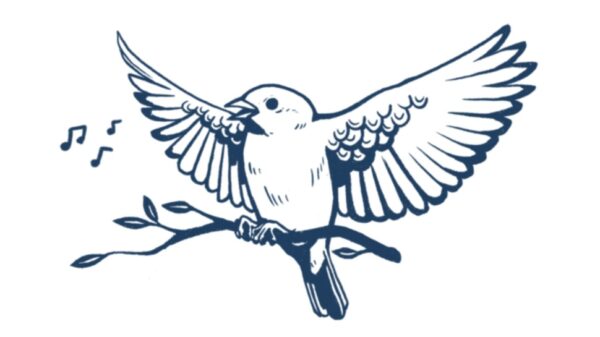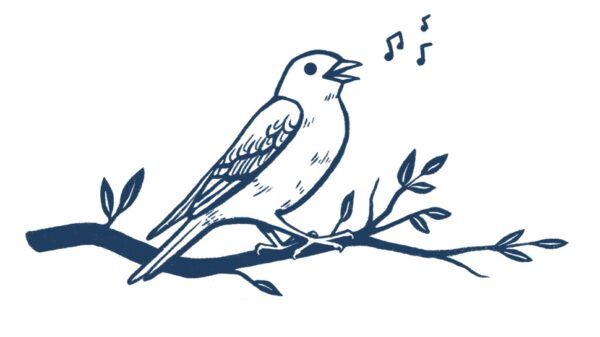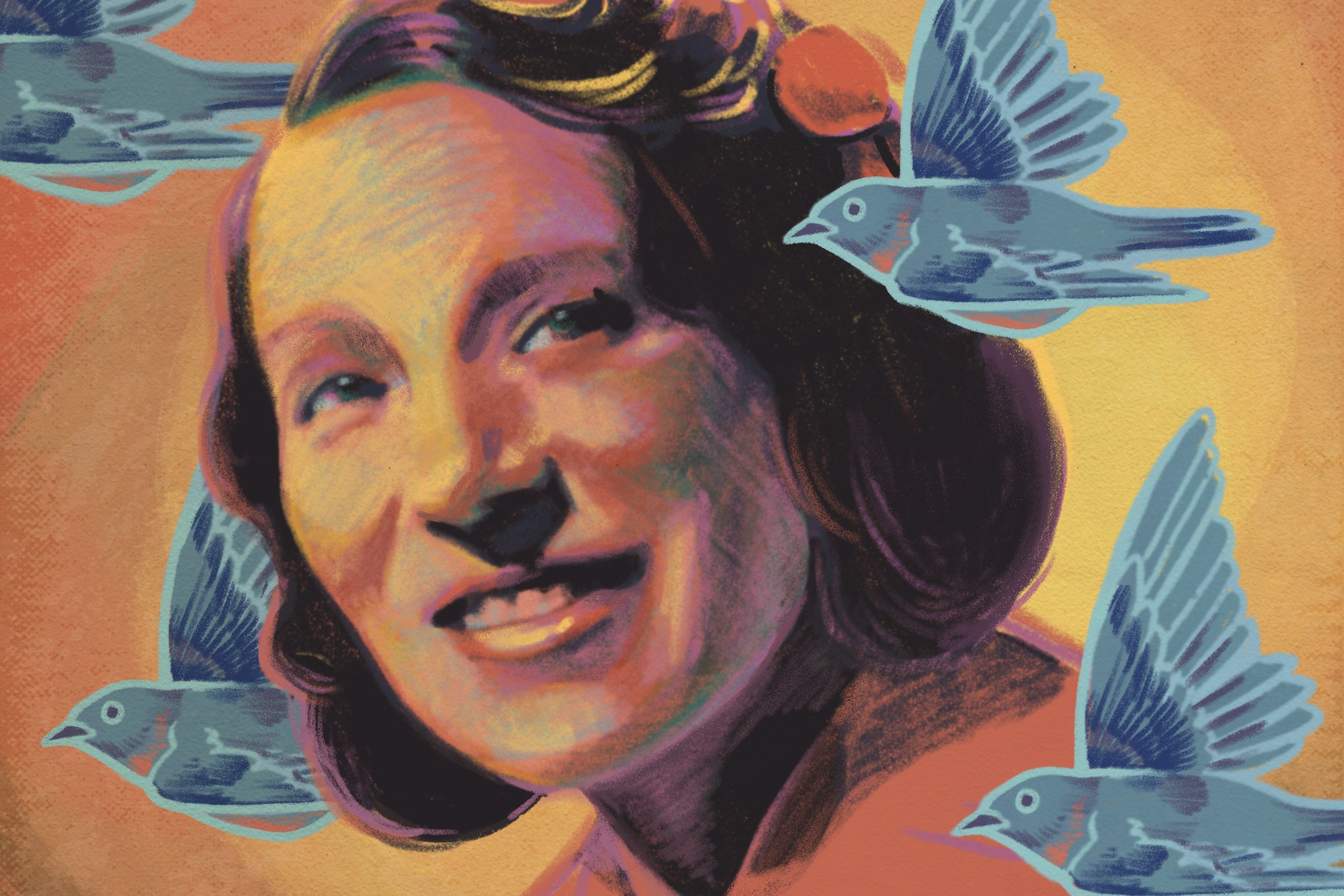On a miserably cold and wet Vancouver evening, a nurse at the children’s hospital was tucking her charges into bed.
The ward was gloomy, the young patients suffering from debilitating diseases. As rain spattered against a window, a baby sparrow crashed into the glass before seeking shelter on a corner of the sill.
“A sad, weeping little boy saw the bird, pointed to it and asked me to bring it in from the cold,” Elizabeth Clarke later wrote in a magazine for nurses. “I lifted in the tiny bird; all the children were enraptured. As I tucked them in again, I told them it was a little bird of happiness.”
A minor incident on a gloomy night on a sad hospital ward would inspire the nurse to write a poem. Soon after, a tune popped into her head and she set her words to music.
“I didn’t intend to write it,” she said, “it just came.”
The first song she ever published became a sensation in 1949. “There’s a Bluebird on Your Windowsill” was recorded by Doris Day, Hank Williams, and Bing Crosby, among many others, selling more than one million copies. Clarke became the first Canadian composer to reach that milestone.
The reception to her song made her aspire to success on Tin Pan Alley, though she never abandoned her job as a nurse (on what might be called Bed Pan Alley.) A kindly presence on the hospital ward, Clarke felt making children happy was a key to easing their suffering and, perhaps, spurring recovery.
She was born in Winnipeg in 1911 to Russian immigrant parents of German ancestry. Her father worked as a bottler at a brewery. The family later moved to Saskatchewan, where she attended Regina College before completing nurses training school at Swift Current General Hospital. In a wedding held at the Lutheran church in the village of Hodgeville on July 21, 1935, she married John Wanstall Clark, a hazel-eyed doctor whose two brothers were also doctors, while a sister was a registered nurse. (The family surname would be almost universally misspelled as Clarke, even on the record labels.) The groom was 49, the bride just 24. They honeymooned in Banff.
The couple moved to Vancouver during the Second World War, living in a modest cottage at 361 West 22nd Avenue. John opened an office in the Broadway Medical-Dental Building, 532 W. Broadway, while Elizabeth took a position with what was known at the time as the Hospital for Sick and Crippled Children.
She had dabbled in the arts all her life, winning an honourable mention in a drawing contest at age 12 and writing poetry as she completed her studies. The nurse sometimes wrote lullabies from her poems, which she then recorded on disks for use to cheer up children in the hospital.

“One of my patients, a little five-year-old girl, who had never spoken a word, is an example of how children can and do crystallize other musical impressions when provided with the right stimulus,” she wrote for Trained Nurse magazine in 1950.
“For several days I had been playing a recording in the ward of ‘Just a Broken-Down Dolly,’ which I had composed based on my childhood experiences. When I started to take the record player away for the night, she screamed, ‘Don’t!’ Turning, I said, ‘Want it to stay?’ and again she spoke with much difficulty, ‘Yes.’ Those were her first spoken words! Now she is taking speech training and is able to ask for things.”
The nurse was still an unpublished writer when she sat down to put the story of the windblown sparrow onto the page. She took artistic liberties in the catchy refrain, replacing the plain songbird with a colourful bluebird.
There’s a bluebird on your windowsill,
There’s a rainbow in your sky.
There are happy thoughts, your heart to fill,
Near enough to make you cry.
The Rhythm Pals, a trio who appeared daily on CKNW, performed her song, after which the radio station was flooded with requests. She signed with Empire Music Publishers in New Westminster for the release of sheet music, spending her own money to promote the tune.
In a few short months, the song swept the continent as pop, country, and jazz performers released recordings, including the Andrews Sisters, 101 Ranch Boys, Tex Williams and his Western Caravan, and the yodeler Wilf Carter with the Calgary Stampeders. (In the United States, Carter performed as Montana Slim. He released a version of the song there credited to the Big Hole Bronco Busters.) The tune was recorded as a foxtrot by several big band orchestras, including those fronted by George Towne, Carmen Cavallaro, and Freddy Martin, the latter with Merv Griffin handling vocal duties.
Doris Day, who was featured as a singer on the Bob Hope Show, got a laudatory review in Billboard magazine, which called her version “cute as a button” in a “fine rhythm rendition of a tune which has been finding warm reception via the country disk route.”
At the height of the frenzy over the song, Wilf Carter showed up unannounced at the children’s hospital. He sang “Bluebird” and his many other hits for the young patients and their nurses.
The nurse went from anonymity to appearing on CBC’s Canadian Cavalcade radio show in Toronto. She told a national audience the story of the song’s origins, while George Murray sang a Mart Kenney arrangement in her honour.
She soon after appeared on stage at the Capitol Theatre in Vancouver to perform her song as part of a Christmas production aired live by radio station CKWX.

A slender woman with an earnest but kindly approach, she found herself in the unaccustomed company of vocal and radio stars who were keen to share her story with their audiences. Late in 1949, the American March of Dimes announced “Bluebird on Your Windowsill” would be the theme song for the charity’s massive annual fundraising drive.
Clarke subscribed to Billboard and other music trade journals, paying out of her own pocket to record demos of her latest songs. She wrote a Dixieland tune, “The Ring You Gave to Me,” inspired by a child patient; “Bright Golden Sunbeams,” about first steps taken by a 14-year-old girl named Yvonne after three years of bedrest; and “Picking Flowers,” which was recorded by top cowboy singer Earl Heywood and popular Western singer Keray Regan. None came close to the success of her debut.
“Bluebird” continued to find an audience over the years. In 1969, BMI (Canada) Ltd., which collects and distributes royalties, honoured the song with an award at the organization’s first-ever award ceremony. Stompin’ Tom Connors got around to recording his own version in 1971, while the filmmaker Sandy Wilson included it in her 1985 coming-of-age movie, My American Cousin, set and filmed in the Okanagan. In 2010, Clarke was inducted into the Canadian Songwriters Hall of Fame, 63 years after being inspired by children’s excitement over a wet bird.
The songwriting nurse passed away at a young age. A decade after being diagnosed with heart disease and a year after suffering heart failure, she suffered a pulmonary edema, a buildup of fluid in the lungs. She died at Altamont Private Hospital in West Vancouver on July 23, 1960. She was just 48. She was buried next to her husband at Forest Lawn Cemetery in Burnaby.
At her funeral, a soloist sang the “Twenty-Third Psalm.” The organist did not perform “Bluebird.” In his eulogy, Rev. Fred W. Lee noted she had “a poet’s soul.”
But her death left unanswered a mystery about her personal life.
As her song climbed the record charts, newspapers published profiles with more than one describing the heartbroken nurse as a widow. She was listed as such in the city directories. It was reported her husband had retired from medical practice in 1943 before being sent to the famous Mayo Clinic in Minnesota for undisclosed treatment.
In fact, Dr. Clark did not die until 1958. His wife signed his death certificate.
Before his death, another man, Bernard Vickers, a washer for a laundry company, would be listed as a resident in the cottage on West 22nd Avenue. It is unknown if he was a tenant, a boarder, or a romantic partner. In any case, Vickers signed Clarke’s death certificate, describing himself as a friend on the document.
(Vickers himself came to a tragic end in 1974, when he died of burns several days after his clothing was doused with a flammable liquid during a drinking party. A coroner’s jury did not reach a conclusion whether the incident was a homicide or an accident.)
Whatever sorrow she had in her private life, Clarke, who was childless herself, put her creative energies into comforting her young patients.
“The biggest thrill I get is seeing these children smile when I visit them in the hospital wards,” she said, “which means they’re happy and they can’t be happy unless we all help to make them well.”
By contributing her share of royalties from the song to charities supporting sick children, she gave them a gift lasting much longer than a two-minute song.
Read more local history stories.









